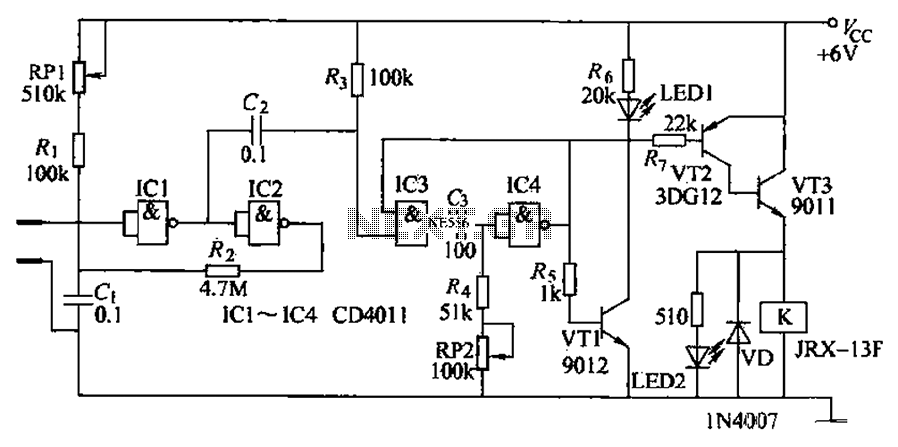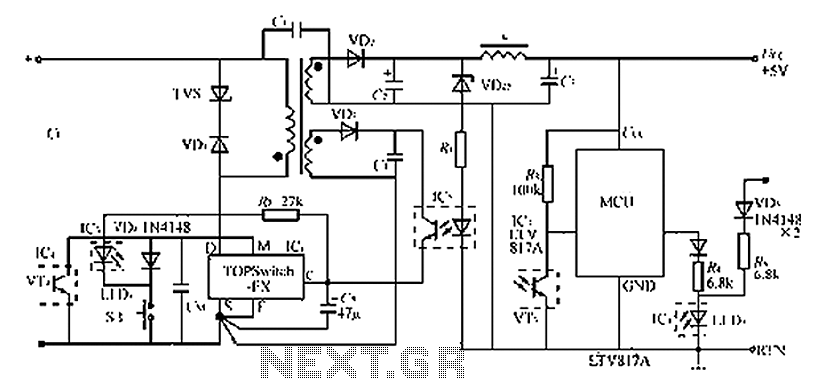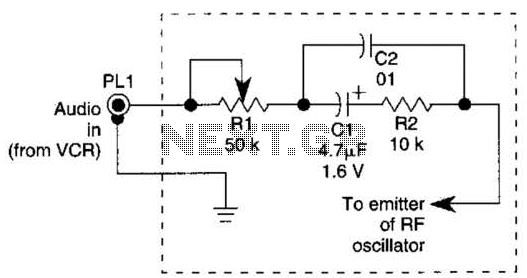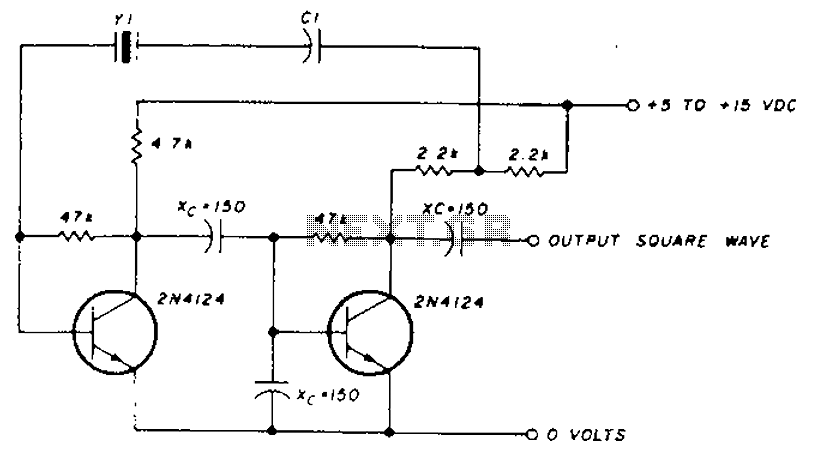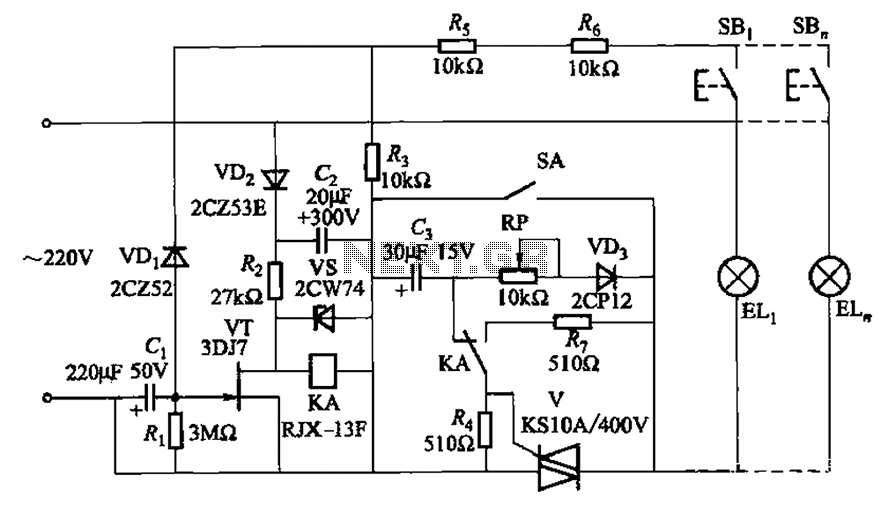
voltage regulator circuit with pass

This is a simple design for a voltage regulator circuit using a pass transistor. The design is built around the LM317T. The output current of the LM317T can be increased by incorporating an additional power transistor to share a portion of the total current. The current sharing is determined by a resistor placed in series with the LM317 input and another resistor in series with the emitter of the pass transistor. The circuit operates such that the pass transistor begins conducting when the LM317 current reaches approximately 1 amp, triggered by the voltage drop across a 0.7-ohm resistor. Current limiting occurs at about 2 amps for the LM317, resulting in a voltage drop of approximately 1.4 volts across the 0.7-ohm resistor and a 700 millivolt drop across the 0.3-ohm emitter resistor. Consequently, the total current is limited to about 2 + (0.7 / 0.3) = 4.3 amps. The input voltage must be around 5.5 volts greater than the output at full load, and heat dissipation at full load would be approximately 23 watts, necessitating a substantial heat sink for both the regulator and the pass transistor. The size of the filter capacitor can be estimated using the formula C = IT/E, where I is the current, T is the half-cycle time (8.33 ms at 60 Hertz), and E is the voltage drop that occurs during one half-cycle. To maintain the ripple voltage below 1 volt at 4.3 amps, a filter capacitor of 36,000 µF or greater is required. The power transformer must be adequately sized to ensure that the peak input voltage to the regulator remains 5.5 volts above the output at full load, which would be 17.5 volts for a 12-volt output. This accommodates a 3-volt drop across the regulator, a 1.5-volt drop across the series resistor (0.7 ohm), and 1 volt of ripple produced by the filter capacitor. A larger filter capacitor will reduce the input requirements, but the effect will be minimal.
The voltage regulator circuit described utilizes the LM317T as a primary regulator, which is a popular adjustable voltage regulator capable of providing a stable output voltage. The inclusion of a pass transistor allows for higher output currents by sharing the load, effectively increasing the current handling capability of the circuit. The series resistors play a critical role in determining the current sharing between the LM317T and the pass transistor, ensuring that the LM317T does not exceed its current limit.
The operation of the circuit can be further analyzed by considering the thermal management requirements. The heat generated by the LM317T and the pass transistor during operation must be dissipated effectively to prevent thermal shutdown or damage. A heat sink with adequate thermal conductivity and surface area is essential to maintain safe operating temperatures, especially under maximum load conditions where the heat dissipation can reach 23 watts.
The filter capacitor is crucial for smoothing the output voltage and reducing ripple. The calculation for the capacitor size using the formula C = IT/E is essential for ensuring that the output voltage remains stable under load conditions. The choice of a 36,000 µF capacitor reflects the need to maintain a ripple voltage below 1 volt, which is critical for sensitive electronic applications.
The power transformer must be selected based on the output voltage requirements and the additional headroom needed for the regulator to function correctly. Ensuring that the transformer provides at least 5.5 volts above the desired output voltage at full load is vital for maintaining regulation and performance.
In summary, this voltage regulator circuit design effectively combines the LM317T with a pass transistor to provide a robust solution for applications requiring higher output currents, while also emphasizing the importance of thermal management and component selection for reliable operation.This is a simple design for Voltage Regulator Circuit using pass transistor. The design has built by LM317T. The LM317T output current can be increased by using an additional power transistor to share a portion of the total current. The amount of current sharing is established with a resistor placed in series with the 317 input and a resistor plac
ed in series with the emitter of the pass transistor. The circuit is show in the figure below. In the figure, the pass transistor will start conducting when the LM317 current reaches about 1 amp, due to the voltage drop across the 0. 7 ohm resistor. Current limiting occurs at about 2 amps for the LM317 which will drop about 1. 4 volts across the 0. 7 ohm resistor and produce a 700 milli volt drop across the 0. 3 ohm emitter resistor. Thus the total current is limited to about 2+ (. 7/. 3) = 4. 3 amps. The input voltage will need to be about 5. 5 volts greater than the output at full load and heat dissipation at full load would be about 23 watts, so a fairly large heat sink may be needed for both the regulator and pass transistor.
The filter capacitor size can be approximated from C=IT/E where I is the current, T is the half cycle time (8. 33 mS at 60 Hertz), and E is the fall in voltage that will occur during one half cycle. To keep the ripple voltage below 1 volt at 4. 3 amps, a 36, 000 uF or greater filter capacitor is needed. The power transformer should be large enough so that the peak input voltage to the regulator remains 5.
5 volts above the output at full load, or 17. 5 volts for a 12 volt output. This allows for a 3 volt drop across the regulator, plus a 1. 5 volt drop across the series resistor (0. 7 ohm), and 1 volt of ripple produced by the filter capacitor. A larger filter capacitor will reduce the input requirements, but not much. 🔗 External reference
The voltage regulator circuit described utilizes the LM317T as a primary regulator, which is a popular adjustable voltage regulator capable of providing a stable output voltage. The inclusion of a pass transistor allows for higher output currents by sharing the load, effectively increasing the current handling capability of the circuit. The series resistors play a critical role in determining the current sharing between the LM317T and the pass transistor, ensuring that the LM317T does not exceed its current limit.
The operation of the circuit can be further analyzed by considering the thermal management requirements. The heat generated by the LM317T and the pass transistor during operation must be dissipated effectively to prevent thermal shutdown or damage. A heat sink with adequate thermal conductivity and surface area is essential to maintain safe operating temperatures, especially under maximum load conditions where the heat dissipation can reach 23 watts.
The filter capacitor is crucial for smoothing the output voltage and reducing ripple. The calculation for the capacitor size using the formula C = IT/E is essential for ensuring that the output voltage remains stable under load conditions. The choice of a 36,000 µF capacitor reflects the need to maintain a ripple voltage below 1 volt, which is critical for sensitive electronic applications.
The power transformer must be selected based on the output voltage requirements and the additional headroom needed for the regulator to function correctly. Ensuring that the transformer provides at least 5.5 volts above the desired output voltage at full load is vital for maintaining regulation and performance.
In summary, this voltage regulator circuit design effectively combines the LM317T with a pass transistor to provide a robust solution for applications requiring higher output currents, while also emphasizing the importance of thermal management and component selection for reliable operation.This is a simple design for Voltage Regulator Circuit using pass transistor. The design has built by LM317T. The LM317T output current can be increased by using an additional power transistor to share a portion of the total current. The amount of current sharing is established with a resistor placed in series with the 317 input and a resistor plac
ed in series with the emitter of the pass transistor. The circuit is show in the figure below. In the figure, the pass transistor will start conducting when the LM317 current reaches about 1 amp, due to the voltage drop across the 0. 7 ohm resistor. Current limiting occurs at about 2 amps for the LM317 which will drop about 1. 4 volts across the 0. 7 ohm resistor and produce a 700 milli volt drop across the 0. 3 ohm emitter resistor. Thus the total current is limited to about 2+ (. 7/. 3) = 4. 3 amps. The input voltage will need to be about 5. 5 volts greater than the output at full load and heat dissipation at full load would be about 23 watts, so a fairly large heat sink may be needed for both the regulator and pass transistor.
The filter capacitor size can be approximated from C=IT/E where I is the current, T is the half cycle time (8. 33 mS at 60 Hertz), and E is the fall in voltage that will occur during one half cycle. To keep the ripple voltage below 1 volt at 4. 3 amps, a 36, 000 uF or greater filter capacitor is needed. The power transformer should be large enough so that the peak input voltage to the regulator remains 5.
5 volts above the output at full load, or 17. 5 volts for a 12 volt output. This allows for a 3 volt drop across the regulator, plus a 1. 5 volt drop across the series resistor (0. 7 ohm), and 1 volt of ripple produced by the filter capacitor. A larger filter capacitor will reduce the input requirements, but not much. 🔗 External reference
Warning: include(partials/cookie-banner.php): Failed to open stream: Permission denied in /var/www/html/nextgr/view-circuit.php on line 713
Warning: include(): Failed opening 'partials/cookie-banner.php' for inclusion (include_path='.:/usr/share/php') in /var/www/html/nextgr/view-circuit.php on line 713
